Proper placement of ett - Study guides, Class notes & Summaries
Looking for the best study guides, study notes and summaries about Proper placement of ett? On this page you'll find 87 study documents about Proper placement of ett.
Page 4 out of 87 results
Sort by
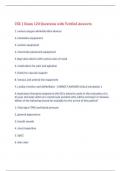
-
CSE 1 Exam 120 Questions with Verified Answers,100% CORRECT
- Exam (elaborations) • 33 pages • 2023
-
- $11.49
- + learn more
CSE 1 Exam 120 Questions with Verified Answers 1. various oxygen administration devices 2. intubation equipment 3. suction equipment 4. chest tube placement equipment 5. Bag-valve device with various sizes of mask 6. medications for pain and agitation 7. fluids for vascular support 8. Venous and arterial line equipment 9. cardiac monitor and defibrillator - CORRECT ANSWER clinical simulation 1 A respiratory therapist assigned to the ED is asked to assist in t...
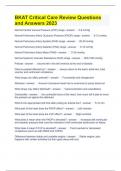
-
BKAT Critical Care Review Questions and Answers 2023
- Exam (elaborations) • 5 pages • 2023
- Available in package deal
-
- $17.99
- + learn more
BKAT Critical Care Review Questions and Answers 2023 Normal Central Venous Pressure (CVP) range 2-8 mmHg Normal Pulmonary Artery Occlusion Pressure (PAOP) range 6-12 mmHg Normal Pulmonary Artery Systolic (PAS) range 20-30 mmHg Normal Pulmonary Artery Diastolic (PAD) range 5-15 mmHg Normal Pulmonary Artery Mean (PAM) 11-20 mmHg Normal Systemic Vascular Resistance (SVR) range 800-1200 mmHg Preload volume left in the left ventricle at the end of dia...
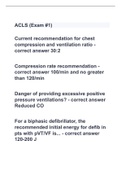
-
ACLS (Exam #1) graded A
- Exam (elaborations) • 6 pages • 2023
- Available in package deal
-
- $10.49
- + learn more
Current recommendation for chest compression and ventilation ratio 30:2 Compression rate recommendation 100/min and no greater than 120/min 00:02 01:29 Danger of providing excessive positive pressure ventilations? Reduced CO For a biphasic defibrillator, the recommended initial energy for defib in pts with pVT/VF is... 120-200 J Ideal compression depth? 2 in and no greater than 2.4 in The most reliable method of confirming proper ETT placement is...
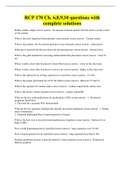
-
RCP 170 Ch. 6,8,9,10 questions with complete solutions
- Exam (elaborations) • 3 pages • 2023
- Available in package deal
-
- $11.49
- + learn more
Define cardiac output correct answer: the amount of blood ejected from the heart over the course of one minute What is the most important hemodynamic measurement correct answer: Cardiac output What is the primary site for arterial puncture in neo and peds correct answer: radial artery What site is reserved for the last choice for arterial puncture correct answer: Femoral rtery What is the gold standard for assessing endotracheal tube placement correct answer: Chest X-ray Wher...
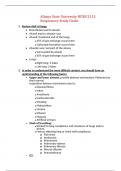
-
Albany State University NURS 2115 Respiratory Study Guide,100% CORRECT
- Exam (elaborations) • 51 pages • 2023
-
- $16.49
- + learn more
Albany State University NURS 2115 Respiratory Study Guide 1. Review A&P of lungs: • Bronchioles lead to alveoli • Alveoli lead to alveolar sacs • Alveoli: functional unit of the lungs o 35% of gas exchange occurs here o Surfactant formation occurs here • Alveolar sacs: last part of the airway o Surrounded by alveoli o 65% of gas exchange occurs here • Lungs: o Right lung: 3 lobes o Left lung: 2 lobes 2. In order to understand the more difficult content, you should have an ...
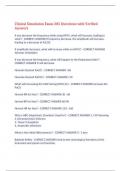
-
Clinical Simulation Exam 285 Questions with Verified Answers,100% CORRECT
- Exam (elaborations) • 22 pages • 2023
-
- $12.49
- + learn more
Clinical Simulation Exam 285 Questions with Verified Answers If you decrease the frequency while using HFOV, what will increase, leading to what? - CORRECT ANSWER If frequency decrease, the amplitude will increase, leading to a decrease in PaCO2. If amplitude increases, what will increase while on HFOV? - CORRECT ANSWER Alveolar Ventilation If you decrease the frequency, what will happen to the Respiratory Rate? - CORRECT ANSWER It will decrease Neonate Desired PaO2? - CORRECT ANSWER...
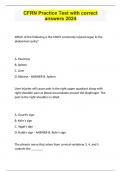
-
CFRN Practice Test with correct answers 2024.
- Exam (elaborations) • 95 pages • 2024
-
- $7.99
- + learn more
Which of the following is the MOST commonly injured organ in the abdominal cavity? A. Pancreas B. Spleen C. Liver D. Kidneys - ANSWER-B. Spleen Liver injuries will cause pain in the right upper quadrant along with right shoulder pain as blood accumulates around the diaphragm. The pain in the right shoulder is called: A. Gourd's sign B. Kehr's sign C. Vagal's sign D. Hobb's sign - ANSWER-B. Kehr's sign The phrenic nerve that arises from cervical vertebrae 3, 4, an...
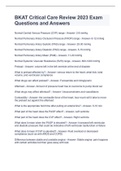
-
BKAT Critical Care Review 2023 Exam Questions and Answers
- Exam (elaborations) • 5 pages • 2023
- Available in package deal
-
- $9.99
- + learn more
Normal Central Venous Pressure (CVP) range - Answer- 2-8 mmHg Normal Pulmonary Artery Occlusion Pressure (PAOP) range - Answer- 6-12 mmHg Normal Pulmonary Artery Systolic (PAS) range - Answer- 20-30 mmHg Normal Pulmonary Artery Diastolic (PAD) range - Answer- 5-15 mmHg Normal Pulmonary Artery Mean (PAM) - Answer- 11-20 mmHg Normal Systemic Vascular Resistance (SVR) range - Answer- 800-1200 mmHg Preload - Answer- volume left in the left ventricle at the end of diastole What i...
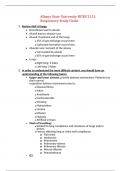
-
Albany State University NURS 2115 Respiratory Study Guide,100% CORRECT
- Exam (elaborations) • 51 pages • 2023
-
- $15.49
- + learn more
Albany State University NURS 2115 Respiratory Study Guide 1. Review A&P of lungs: • Bronchioles lead to alveoli • Alveoli lead to alveolar sacs • Alveoli: functional unit of the lungs o 35% of gas exchange occurs here o Surfactant formation occurs here • Alveolar sacs: last part of the airway o Surrounded by alveoli o 65% of gas exchange occurs here • Lungs: o Right lung: 3 lobes o Left lung: 2 lobes 2. In order to understand the more difficult content, you should have an ...

-
PALS QUESTIONS WITH CORRECT ANSWERS RATED A+
- Exam (elaborations) • 5 pages • 2024
- Available in package deal
-
- $10.99
- + learn more
compression to breath ratio children with 1 rescuer - 30:2 2 rescuer compression to breath ratio? - 15:2 Initial impression of a 2-year old girl shows her to be alert with mild breathing difficulty during inspiration and pale skin color. On primary assessment, she makes high pitched inspiratory sound (mild stridor) when agitated; otherwise, intercoastal retractions. Lung auscultation reveals transmitted upper airway sounds with adequate distal breath sounds bilaterally. Which is the ...

Do you wonder why so many students wear nice clothes, have money to spare and enjoy tons of free time? Well, they sell on Stuvia! Imagine your study notes being downloaded a dozen times for $15 each. Every. Single. Day. Discover all about earning on Stuvia


